Weight of cast iron radiator section: quantity calculation
Cast iron batteries have been used to heat homes for more than a century. But, despite such a serious age, they honorably withstand tough competition with new-fangled materials and firmly occupy their niche. Giving preference to cast iron, the first thing that the future owner thinks about is how much 1 section of the cast iron radiator weighs. We will discuss this and other related characteristics of this material further.
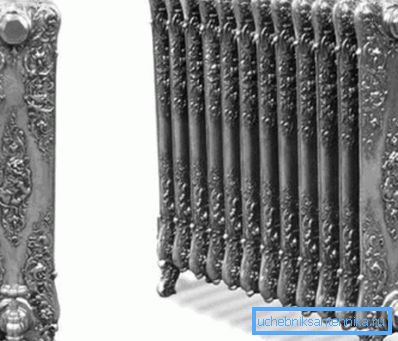
Why love cast iron batteries
Of course, if you have to replace or install the battery yourself, then the question of how much a section of a cast-iron radiator weighs will be one of the first, but far from unique.
Indeed, by and large, delivery and installation can be paid for, but how well the product itself is of more interest to the normal owner.
- Since this product is intended for space heating, the characteristics of heat transfer and power are here in the first place.. According to these parameters, cast iron loses steel and aluminum. But the standard instruction, as a rule, does not contain information about the heat capacity, and it is here that the grandfather cast iron is far ahead of its competitors. The metal heats up for a long time, but it also cools for a long time.
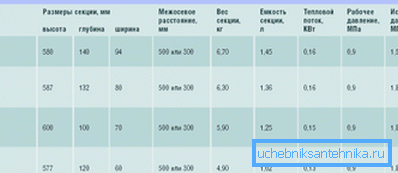
Important: thermal inertness of the metal is not so significant in the centralized systems of multi-storey buildings. But in local networks with controlled coolant temperature or natural circulation, cast iron is out of competition.
- For durability, this metal also occupies a leading position., it does not corrode, so the average service life of such batteries is 30 - 40 years. Although in some apartments to this day there are radiators installed half a century ago.
- Far from the last plus is the absolute neutrality of cast iron.. If in a private house you can personally control the quality of the coolant, then in large networks a rigid cocktail flows through the pipes, which not every material is able to withstand.
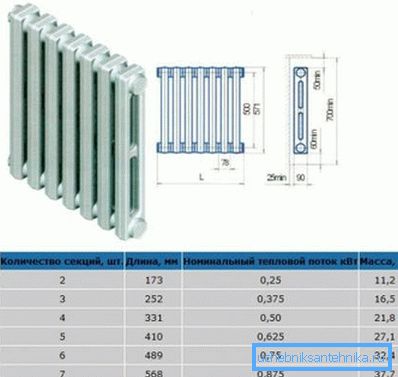
- Of course, the weight of one section of cast-iron radiators is quite tangible, but at the same time, these structures have wide channels, through which any garbage slips easily. This is especially true for large networks, where the quality of the coolant leaves much to be desired. Sand, rust particles and other "surprises" are not intimidating for such batteries.
- In addition, the working pressure for cast iron batteries is 9 atmospheres., Moreover, in urban networks this indicator rarely exceeds 6 atmospheres. Plus, having rather thick walls and a large weight of one section of the cast-iron radiator, these structures are able to withstand a hydraulic shock with a capacity of up to 15 atmospheres.

- If aluminum or bimetallic batteries occupy a certain price category, then the line of cast-iron radiators is deservedly considered to be almost the widest. The price of standard MS-140 is available to almost everyone, then the cost gradually grows depending on the quality of the casting and the brand of the manufacturer.
Important: all products of this kind are initially sold unpainted. This is very convenient, since with the existing range of modern heat-resistant paints, the battery can be decorated with any hands for any interior.
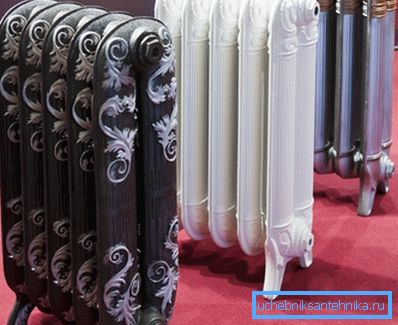
Power and weight of radiators
The weight of 1 section of a pig-iron radiator of heating, directly depends on dimensions and internal volume. In turn, the dimensions of the structure in the collection affect the amount of heat generated.
Calculate the number of sections
At the moment there are several common methods of calculation. Specialists, designers use fairly complex formulas, which take into account the whole complex of characteristics of the room. But at the household level, everything can be done much easier.
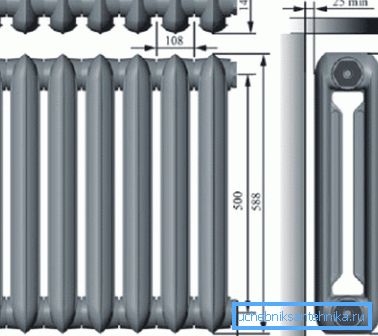
For standard high rises, in which the height of the ceilings, as a rule, does not exceed 3 meters, the heating is 1m? square need to spend 100 watts of thermal energy. Instructions for any battery contains data on the power of one section.
So for cast iron MS-140, this value is 160 watts. Multiplying the square of a room by 100 and dividing by 160, you get the required number of sections. If the number is fractional, it’s better to round up.
For private cottages on 2 or more floors, it is better to make a start not from the square, but from the volume of the room. On average, warming up 1m? room takes about 41 watts. Multiplying the length, width and height you get the internal volume, which in turn is multiplied by 41 watts. Further, as in the first case, the resulting value is divided by the power of 1 section.
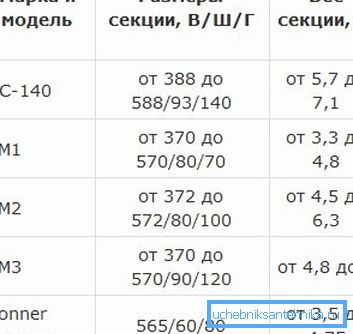
Important: all these calculations are correct for standard rooms with 1 window and 1 wall bordering the street. If there are more windows and external walls, and also when there is access to a balcony or an unheated room from above, the final figure increases by 20%.
A few words about the installation
How much one section of a cast iron radiator weighs can be found in the instructions or special tables, some of which are presented in the article. For example, one section of the most common domestic MS-140 battery weighs 7.12 kg. It holds a half liter of coolant and has an average power of 160 watts.

Having made no clever calculations, it can be found out that the weight of the cast iron radiator on 7 sections of MS-140 filled with coolant will be about 60.34 kg (8.62x7 = 60.34). A similar, but empty battery will weigh 49.84 kg. According to the existing labor protection standards, it is prohibited for one person to lift such a structure. Plus, not every wall can withstand this battery.

According to SNiP 3.05.01-85, for hanging a cast iron radiator from 6 to 8 sections on a concrete or brick wall, two canopies at the top and one at the bottom center are sufficient. In the case of an increase in the number of cells for every 5 - 7 pieces, one lower and upper fastener is added.
The walls of many modern houses are built of light porous materials. They are certainly warm and durable, but they are not capable of withstanding, for example, the weight of a cast iron radiator for 7 sections. In this case, outdoor models of cast iron batteries are used, and for structures such as the MS-140, floor racks with clamps, shown in the photo, are installed.
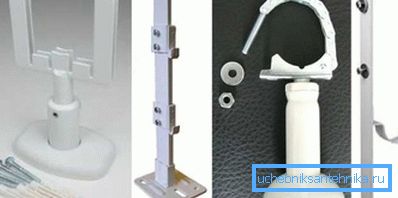
Tip: both the lower pillars and side canopies for cast-iron radiators in their marking must be marked “reinforced”. If you choose brackets from online store catalogs, you need to check this point.

The video in this article provides recommendations on cast iron radiators.
Conclusion
To assert unequivocally that any kind of radiator is the best will not be any specialist. On our website we are trying to tell you about all the advantages and disadvantages of different models. The choice is an individual matter, it depends on personal preferences and specific conditions.
